The
Home Page Selection
If
you require further information on any
print featured here, please contact
us.
When
a print has been sold it will be marked
as Sold.
A
growing archive of selections
from previous Home pages is featured in
the
Home
Page Selection Archive |
|
See
also :
Click
on a thumbnail (left)
to link directly with the entry for that
print, or scroll down to view all the selected
prints from the current Home
Page.
Images
are not to relative scale (see stated dimensions) and also at only modest resolution.
If you wish to view extracts of an image at higher resolution, please Contact us.
|
|
|
|
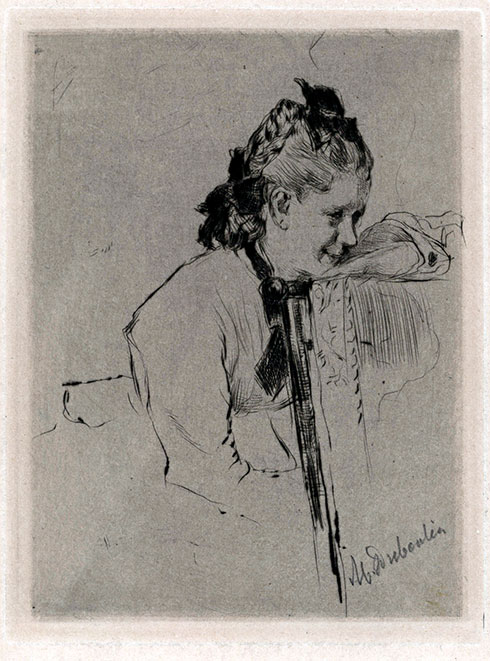
| |
MARCEL DESBOUTIN
Cérilly 1823 – 1902 Nice
In 1872-3, according to Clément Janin, Degas, with the young Giuseppe de Nittis and Jean Béraud, visited Desboutin in his studio, where they happened on and were impressed by a zinc plate by Desboutin. Degas, himself beginning to be interested in printmaking around this time, announced “Parfait. Vous êtes graveur Desboutin; vour êtes sur tout cela!”.
(Perfect. You are an engraver Desboutin; above all you are that!)
From that time Desboutin gave himself enthusiastically to original printmaking.
He disliked acid and carried out all his plates in drypoint, working from his subject straight into the copper.
Blaker wrote of Desboutin in the 1987 issue of the R.E Journal, “The artist was that picturesque character who posed for Manet’s full-length oil of a typical Bohemian; and he is also the male figure at the table in the celebrated Degas of the two drinkers – L’Absinthe ”.
Blaker cites the spontaneity of Desboutin as typical of the French school of etching – “like a note made without forethought on a piece of copper taken from the pocket like a notebook”.
Femme au Métier
Clément-Janin 100
162 x 122 mm
Original drypoint, c1889.
Signed in pencil.
Printed with burr and with plate tone on cream wove paper.
Slight disturbance in the plate tone.
£400
Return to top ^ |
|
|
|
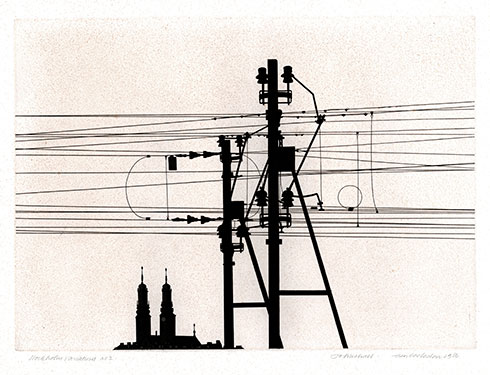
|
|
HARRY ECCLESTON O.B.E., P.R.E.
Cosely, Bilston 1923 – 2010 Harold Hill, Romford
Eccleston grew up in the Black Country on a small housing estate opposite Caponfield steelworks. Industrial ‘landscape’ would inspire him throughout his career.
He was only eleven when he started taking part-time classes at Bilston School of Art and fourteen when he became a fulltime student, receiving instruction from the etcher friends R T Cowern & A H Freeth.
In 1939, aged sixteen, Eccleston went on to attend Birmingham School of Art, until 1942 when he was called up for war service.
With the hiatus of the War, in which he served as an anti-submarine officer in the Royal Navy, it was 1947 when Eccleston began his studies in the Engraving School of the Royal College of Art, under Robert Austin.
A decade later Austin would recommended Eccleston as the first in-house Artist-Designer to the Bank of England; a post he held until 1983, designing the Bank’s ‘D’ series of banknotes issued in 1970, the first fully pictorial notes, with images of Isaac Newton, the Duke of Wellington, Florence Nightingale, Shakespeare and Christopher Wren on the reverse of the Queen’s portrait.
Eccleston was elected an Associate of the R.E. in 1948, while still a student at the R.C.A. and a Fellow in 1961. From 1975 to 1989 he served as President, overseeing the Society’s move from Conduit Street to the Bankside Gallery. He also urged the acceptance of a wider range of printmaking media and began the process to modify the Society’s name to its present title, Royal Society of Paint-Printmakers, ultimately granted in 1991.
Blaker and Eccleston were fellow members of the R.E. and close friends. They regularly visited exhibitions and attended fairs together. Blaker wrote a long article on Eccleston for The Journal of the R.E. issue 8.
Stockholm Variations No.2
252 x350 mm
Original etching, 1986.
Signed in pencil, dated, entitled and dedicated To Michael.
On ivory wove, with pale overall small brown speckles (intrinsic or foxing?).
A short handling crease.
Sold
Electricity wires with a distant view of the twin towers of Högalid Church, Stockholm.
In the 1970’s Eccleston had produced two series of Black Country etchings of iron and steel works, and in the 1980’s, one of electric cables, seen when changing trains at Stratford station when commuting from Essex to London & the Bank of England.
On Platform 8 I would see the electric cable wires every day … it took some time before I could appreciate their beauty … a set of musical variations …
He entitled the resulting series of eleven plates The Stratford Variations.
On a visit to Stockholm, about 1986, he was similarly inspired, and on his return home etched two Stockholm Variations, which would be published by the Black Star Press.
In Blaker’s article in The Journal of the R.E. issue 8, 1986, Eccleston commented on the influence of the geography of where he grew up
All my childhood I had been looking up at things because of this valley – or depression – in which we lived. I was profoundly influenced and impressed by this…
Blaker notices that basic design unifies Eccleston’s contrasting design work at the Bank of England and in his independent prints, where the concept of form sublimating subject into abstraction is increasingly apparent. His banknote designs were small scale with detailed figures and portraits while his prints were much larger and in the later series were without human representation.
Return to top ^ |
|
|
|
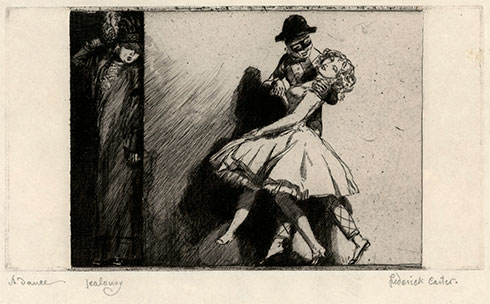 |
|
FREDERICK CARTER A. R.E.
Bradford 1883 – 1967
Carter had finally received parental support to study art in 1904,
and attended the Academy Julian in Paris.
Returned to Bradford he was employed in 1905 as a designer at the Crown Point Printing Works
and it was probably at a Saturday sketch club in Bradford that Carter was introduced to etching.
He settled in London in 1906, working as an illustrator.
From 1908 to 1911 Carter attended Frank Short’s etching classes at the R.C.A., being elected
an Associate of the R.E. in 1910.
His etchings from 1905 to 1916 were largely of characters from the Commedia dell’ Arte,
of which he had first become aware in Paris through Cheret posters.
The drama of the relationships between the characters pre-occupied his ‘first period’ as an artist.
A Dance - Jealousy
Grenville Clark p.32
116 x 213 mm (plate); 116 x 156 mm (image)
Original etching, c1910-11.
Signed in pencil and entitled.
On cream laid paper, time-stained on the reverse.
£150
This and a companion etching A Dance - Desire were inspired by the production for a very small stage
at Clavier Hall, Hanover Square, by the Arts & Dramatic Club, of a ballet pantomime based on the
Commedia dell’Arte, for which Carter designed the costumes and assisted in the direction.
The blank areas to the left and right of the plate, common to both etchings, are suggestive of curtains
to either side of the stage.
Return
to top ^ |
|
|
|
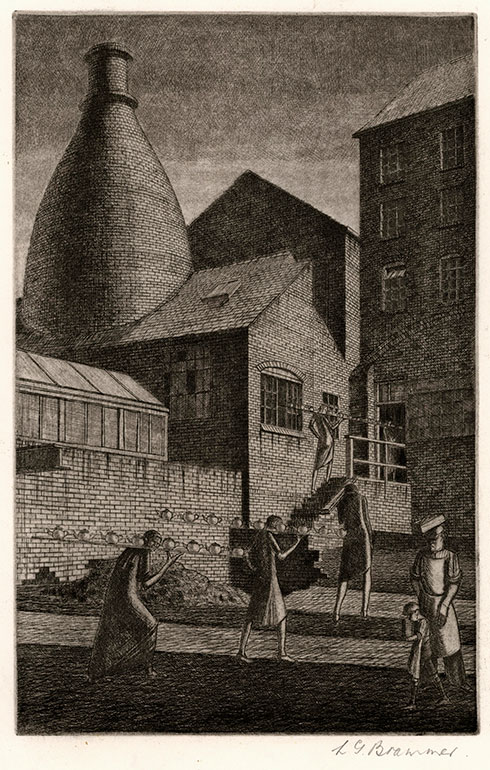 |
|
LEONARD BRAMMER R.E.
Burslem 1906 – 1994 Portmadog
After training at Burslem School of Art, Brammer attended the Royal College of Art in London, graduating in painting in 1929, after which he joined the R.C.A.’s School of Engraving, gaining his Diploma and winning a travelling scholarship in 1930. Brammer took the opportunity to travel to Le Puy and Avignon in France; though most of his future life and work would be centred on “The Potteries”.
Brammer, the son of a designer and builder of pottery ovens, and grandson of a potter, wrote (in the Journal of the R.E. issue 6, 1984, edited by Michael Blaker) about his etchings and being inspired to give expression to the (now disappeared) “Potteries Scene”.
To me the Five Towns landscape of those days, though grim and starkly foreboding, was full of a beauty created by the rich and lovely forms of oven and kiln, the texture of tile and brick, the pattern of roofs and buildings, and the peculiar effect of light and shadow over the Potteries at that time….dramatic skylines …that to me approached magnificence…
In 1975 Paul Drury P.R.E. wrote to Brammer, “I shall always remember your Pottery plates – an outstanding contribution to the history of English etching…”
Michael had a group of over twenty of Brammer’s Potteries prints, which make a remarkable pictorial record of the industry and area, defining a past era of whose visual traces few are left today.
A Factory Scene, Five Towns
(Flaxman Tile) Wade Heath, Burslem
251 x 161 mm
Original etching and drypoint, 1931.
Signed in pencil.
Listed in Fine Prints of the Year as published by
the XXI Gallery in 1932, edition of 25.
Printed in brown-black ink on cream wove simile japan.
Sold
An impression was exhibited at the Royal Academy 1935.
Wade, Heath & Co, whose origins go back to 1810, became a separate company in the 1920’s
and took over the Royal Victoria Pottery (makers of teapots and fancy ware) in 1927.
Wade Heath specialised in Art Deco ‘Flaxman ware’, which in the 1930’s included decoration
with a range of Walt Disney characters. The firm ceased after 1954.
Return
to top ^
|
|
|
|
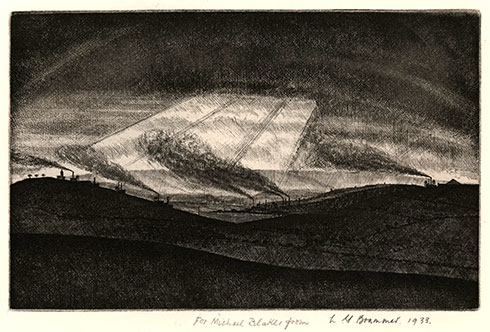 |
|
LEONARD BRAMMER R.E.
Burslem 1906 – 1994 Portmadog
Landscape, Five Towns, Evening
160 x 250 mm
Original etching and drypoint, with roulette, 1932 or 33.
Signed in pencil.
Dated 1933.
A dedicated proof For Michael Blaker.
Also entitled in pencil by the artist at the foot of the sheet.
Printed in brown-black on cream wove.
Thought to be one of fewer than 10 impressions printed.
Sold
An impression entitled Evening Landscape, Five Towns was exhibited at the R.E. in 1955.
Arnold Bennett, another native of The Potteries, coined the name the Five Towns, in his novels, for the group of towns at the centre of the Staffordshire potteries, now amalgamated into the borough of Stoke-on-Trent.
They comprise Burslem, Tunstall, Hanley, Stoke and Longton. Bennett ignored the sixth town, Fenton (as it would appear, so did Brammer), to the annoyance of Fenton residents.
Return
to top ^
|
|
|
|
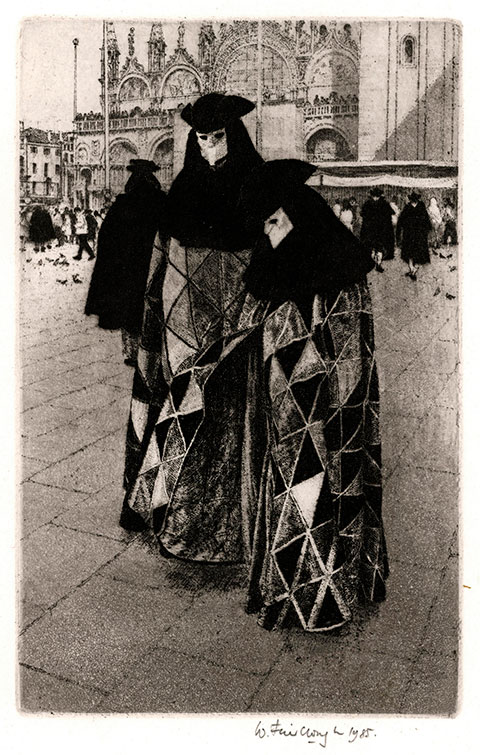 |
|
WILFRED FAIRCLOUGH R.E.
Blackburn 1907 – 1996 Kingston-upon-Thames
Though he had been a Rome Engraving Scholar, because the market for etchings had virtually disappeared by the 1940’s, Fairclough had given up etching then.
A return visit to Italy in 1961, when on a sabbatical year from teaching at Kingston School of Art, inspired him to take up etching again and in his later years Fairclough was a very active member of the R.E.
Venice, Carnival Masks
Lowe 124
175 x 112mm
Original aquatint, 1985.
Signed in pencil and dated.
On stout cream wove paper.
Sold
An impression was exhibited at the R.E. in 1986, when it was awarded the accolade of best print in the show.
Blaker wrote of this prize-winning print in his Etcher’s Diary in the R.E. Journal of 1986
The use he makes of black – always a characteristic – is never taken a degree too far; it never obscures the light, only enhances it. The carnival masks – those strange beak-like masks – are still traditionally worn, just as we see them in the paintings of Pietro Longhi.
(On his mother’s side, Blaker was a descendent of Pietro Longhi.).
Return
to top ^ |
|
|
|
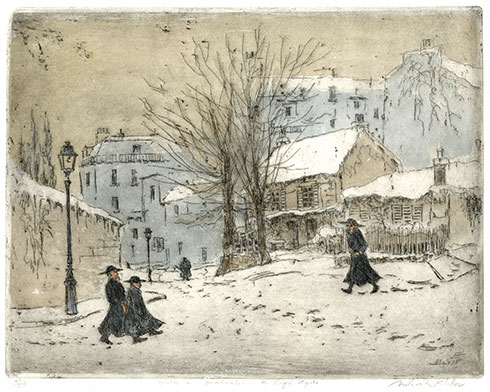
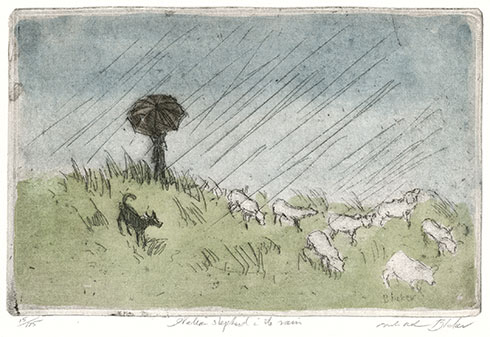
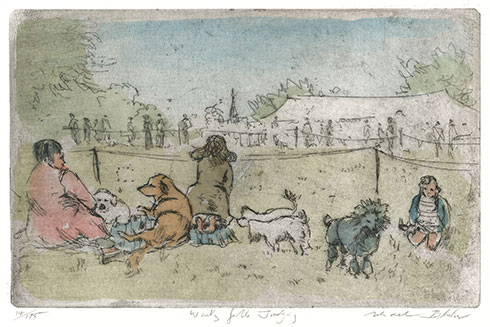
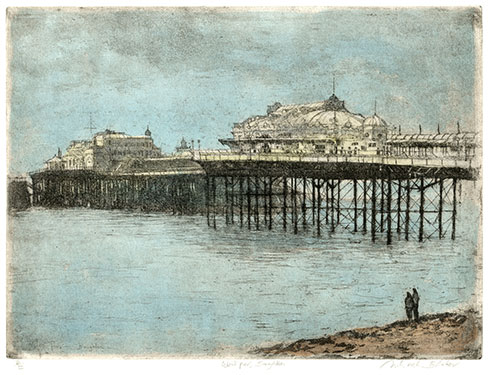
|
|
MICHAEL BLAKER R.E.
Hove 1928 – 2018 Ramsgate
A painter-etcher, writer, and for ten years, 1983-93, editor of the Journal of the Royal Society of Painter-Etchers, Michael Blaker trained at Brighton School of Art, 1945-49 and c1955-58.
He was a lover of art, jazz and animals; he also had an eye for the humour in life.
Winter in Montmartre – the Lapin Agile
340 x 438 mm
Original etching with aquatint and colour wash, c1992.
Signed in pencil, entitled and numbered 27/350 (fewer than
350 were printed).
Sold
On a visit to Paris in 1950, Blaker had witnessed with pleasure
similar priests.
In his Autobiography he records
As I passed the entrance to Sacré Coeur a cadaverous priest passed me,
his mouth open, his eyes turned upwards ... I painted him as I saw him,
contrasted with two more jovial clerics, their skirts creating volutes
beneath which their black boots skimmed happily.
I have made several subsequent versions of this subject, over long periods of time ...
Italian shepherd in the rain
127 x 196 mm
Original etching and colour wash c1980.
Signed in pencil, entitled and numbered 15/175.
Printed with plate tone on cream wove.
£100
Waiting for the Judging
125 x 198 mm
Original etching with colour wash, c1980?.
Signed in pencil, entitled and numbered 14/175.
Printed with plate tone on cream wove.
£125
West Pier Brighton
279 x 378 mm
Original etching, c1972.
One of only three impressions with added colour wash.
Signed in pencil and numbered III/III.
On cream wove paper.
Sold
A monochrome impression was exhibited at the R.E. in 1972.
Return
to top ^
|
|
|
|
|
|
|
|